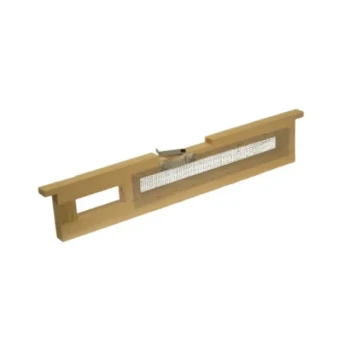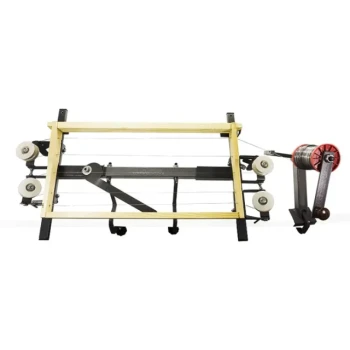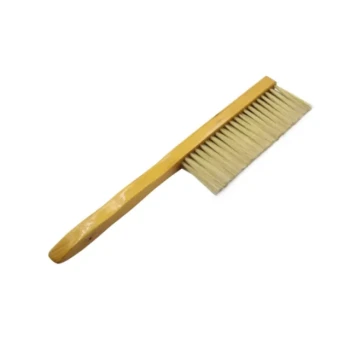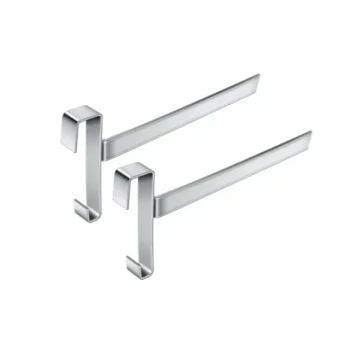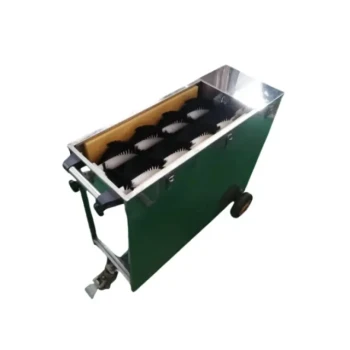In short, the development time for a honey bee is fastest for a queen (about 16 days), intermediate for a worker (about 21 days), and longest for a drone (about 24 days). These timelines begin the moment the egg is laid and are dictated by the bee's caste, which is determined by genetics and, crucially, diet during the larval stage.
Understanding these distinct developmental clocks is not merely academic. It is the fundamental basis for nearly every major decision a beekeeper makes, from managing hive population and timing honey production to controlling pests and raising new queens.
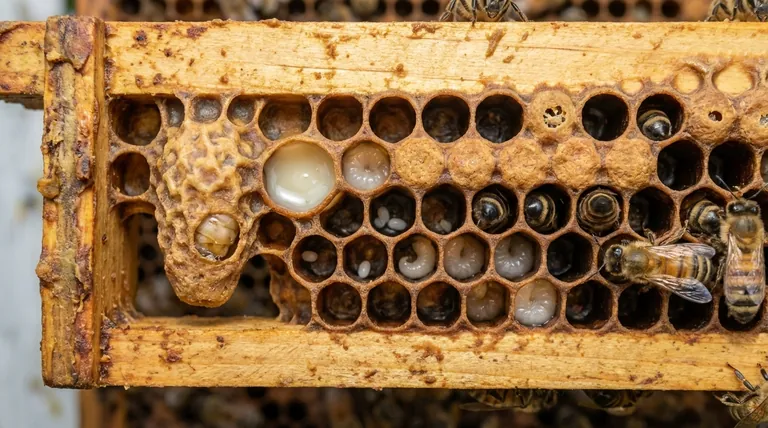
A Breakdown of Developmental Stages
Each honey bee, regardless of caste, passes through four distinct stages: egg, larva, pupa, and adult. While the process is similar, the duration of each stage varies significantly, leading to different emergence times.
The Egg Stage: A Common Start
All bees start as an egg. A fertile queen lays eggs that can become either workers or new queens, while unfertilized eggs become drones.
Regardless of the eventual caste, the egg stage lasts for 3 days for all honey bees.
The Larval Stage: Where Caste is Determined
After hatching, the bee is a small, white larva. This is the primary feeding and growth stage.
A larva destined to be a queen is fed a continuous, exclusive diet of royal jelly. This rich food accelerates her development, and she is ready to be capped in her cell in about 5.5 days.
Worker and drone larvae receive royal jelly for only the first few days, after which their diet is switched to a less-rich mixture of pollen and nectar known as "bee bread." This transition slows their growth. The worker larval stage lasts about 6 days, and the drone's lasts about 6.5-7 days.
The Pupal Stage: Transformation Under the Cap
Once the larval stage is complete, worker bees cap the cell with wax. Inside, the larva spins a cocoon and metamorphoses into a pupa, developing the features of an adult bee.
This is the longest stage, and where the time differences are most pronounced:
- Queen: ~7.5-8 days as a pupa
- Worker: ~12 days as a pupa
- Drone: ~14 days as a pupa
Total Time: From Egg to Emergence
The sum of these stages gives the total time it takes for a new bee to chew through its wax capping and emerge as an adult.
- Queen: Approximately 16 days
- Worker: Approximately 21 days
- Drone: Approximately 24 days
Why These Timelines are Critical
These developmental schedules are the governing rhythm of the colony. A skilled beekeeper uses this knowledge to anticipate the hive's needs and guide its success.
Queen Rearing and Replacement
The 16-day queen cycle is the basis for all queen rearing. If a colony loses its queen, beekeepers know they have only a few days to introduce a new one or ensure the hive has eggs young enough to create an emergency queen.
Population and Honey Production
The 21-day worker cycle is the engine of the hive's economy. To maximize a honey crop, a beekeeper must manage the colony so the peak population of forager bees coincides precisely with the main nectar flow in their region.
Pest Management (The Varroa Mite Cycle)
The longer development time of drones is a critical vulnerability. Varroa mites, the most destructive honey bee pest, reproduce inside capped brood cells.
Because drone brood remains capped for 14 days (longer than worker brood), it allows mites to complete more reproductive cycles. This makes capped drone cells "mite bombs," and savvy beekeepers often remove frames of drone brood as a non-chemical method of trapping and removing mites.
Understanding Common Pitfalls
Misinterpreting these biological timelines can lead to flawed hive management. It is crucial to be precise in your understanding.
Confusing Stage Duration vs. Total Time
Many charts show cumulative days (e.g., "capped on day 9"), while others show the duration of each stage (e.g., "6 days as a larva"). Understand which type of chart you are reading to avoid miscalculation, especially when timing queen-rearing activities.
Forgetting Post-Emergence Maturity
A bee is not fully functional the moment it emerges. Drones, for example, emerge on day 24 but are not sexually mature enough to mate with a queen for another 12-14 days.
Likewise, a new queen emerges around day 16, but she requires several more days to mature and embark on mating flights before she can begin laying eggs.
Not Accounting for Variables
These timelines are reliable averages. However, factors like ambient temperature, hive nutrition, and genetics can cause slight variations of a day or two in either direction.
Making the Right Choice for Your Goal
Your primary objective as a beekeeper will determine which developmental clock you watch most closely.
- If your primary focus is maximizing honey production: Pay closest attention to the 21-day worker bee cycle to ensure your forager population peaks with the nectar flow.
- If your primary focus is raising new queens: Master the 16-day queen timeline to know precisely when to graft larvae, set up cell builders, and prepare mating nucs.
- If your primary focus is integrated pest management: Use the 24-day drone cycle to your advantage by strategically removing capped drone brood to trap and eliminate Varroa mites.
By internalizing these fundamental timelines, you move from simply keeping bees to truly managing them.
Summary Table:
| Caste | Egg Stage | Larval Stage | Pupal Stage | Total Development Time |
|---|---|---|---|---|
| Queen | 3 days | ~5.5 days | ~7.5-8 days | ~16 days |
| Worker | 3 days | ~6 days | ~12 days | ~21 days |
| Drone | 3 days | ~6.5-7 days | ~14 days | ~24 days |
Master Your Hive's Timeline with HONESTBEE
Now that you understand the critical 16, 21, and 24-day developmental clocks, you need reliable equipment to manage your apiary effectively. Whether you are a commercial beekeeper timing honey flows or a distributor supplying quality gear, HONESTBEE provides the durable, wholesale-focused beekeeping supplies you need to succeed.
Let's optimize your beekeeping operations together.
Contact HONESTBEE today to discuss your specific needs for hive management, queen rearing, and pest control equipment.
Visual Guide
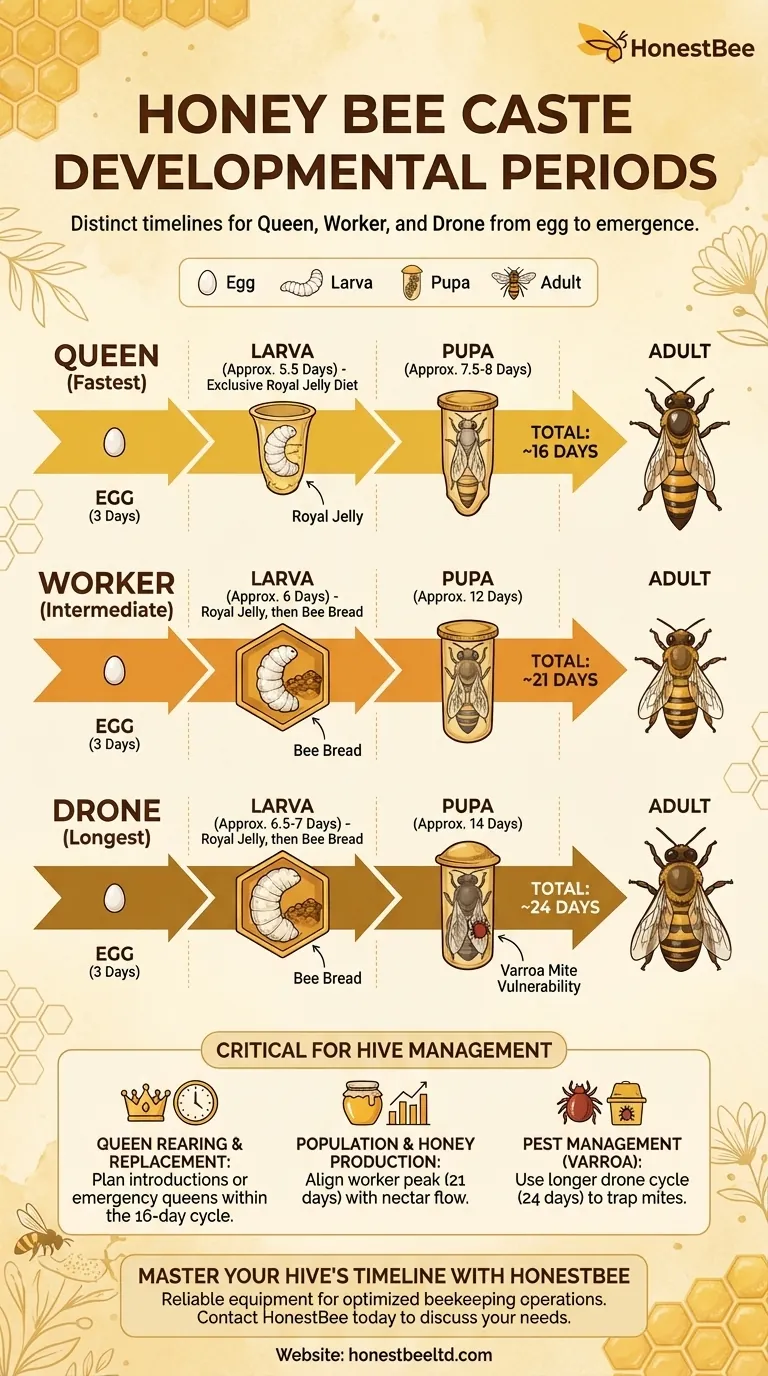
Related Products
- No Grafting Queen Rearing Kit: System for Royal Jelly Production and Queen Rearing
- JZBZ Langstroth Queen Rearing Frame for Beekeeping
- Brown Nicot Queen Cell Cups for Breeding Queen Bees Beekeeping
- Plastic Chinese Queen Grafting Tool for Bee Queen Rearing
- Professional Wooden Requeening Frame for Beekeeping
People Also Ask
- What are the stages involved in queen raising? A Guide to Controlled, High-Quality Queen Production
- How can beekeepers start a honey bee breeding program? Build a Superior, Resilient Apiary
- What is the timeline for queen breeding? A 28-Day Guide from Egg to Laying Queen
- What is requeening, and why is it performed? Take Control of Your Hive's Health and Productivity
- What are the signs that indicate a colony needs requeening? Protect Your Hive's Health and Productivity




